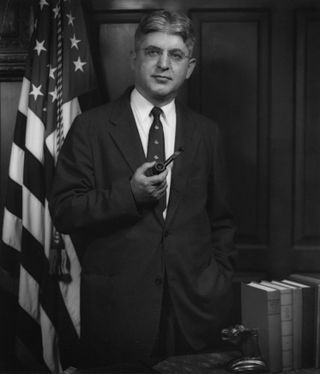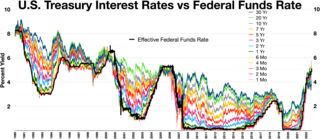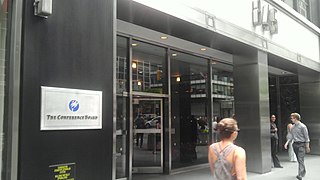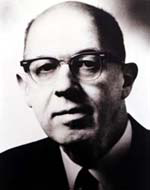Related Research Articles

In economics, a recession is a business cycle contraction that occurs when there is a general decline in economic activity. Recessions generally occur when there is a widespread drop in spending. This may be triggered by various events, such as a financial crisis, an external trade shock, an adverse supply shock, the bursting of an economic bubble, or a large-scale anthropogenic or natural disaster.
An economic indicator is a statistic about an economic activity. Economic indicators allow analysis of economic performance and predictions of future performance. One application of economic indicators is the study of business cycles. Economic indicators include various indices, earnings reports, and economic summaries: for example, the unemployment rate, quits rate, housing starts, consumer price index, Inverted yield curve, consumer leverage ratio, industrial production, bankruptcies, gross domestic product, broadband internet penetration, retail sales, price index, and money supply changes.

Business cycles are intervals of expansion followed by recession in economic activity. A recession is sometimes technically defined as 2 quarters of negative GDP growth, but definitions vary; for example, in the United States, a recession is defined as "a significant decline in economic activity spread across the market, lasting more than a few months, normally visible in real GDP, real income, employment, industrial production, and wholesale-retail sales." The changes in economic activity that characterize business cycles have implications for the welfare of the broad population as well as for private institutions. Typically business cycles are measured by examining trends in a broad economic indicator such as Real Gross Domestic Production.

The National Bureau of Economic Research (NBER) is an American private nonprofit research organization "committed to undertaking and disseminating unbiased economic research among public policymakers, business professionals, and the academic community". The NBER is known for providing start and end dates for recessions in the United States.

Arthur Frank Burns was an American economist and diplomat who served as the 10th chairman of the Federal Reserve from 1970 to 1978. He previously chaired the Council of Economic Advisers under President Dwight D. Eisenhower from 1953 to 1956, and served as the first Counselor to the President under Richard Nixon from January to November 1969. He also taught and researched at Rutgers University, Columbia University, and the National Bureau of Economic Research.
Robert JamesGordon is an American economist. He is the Stanley G. Harris Professor of the Social Sciences at Northwestern University. Gordon is one of the world’s leading experts on inflation, unemployment, and long-term economic growth. His recent work asking whether U.S. economic growth is “almost over” has been widely cited, and in 2016 he was named as one of Bloomberg’s top 50 most influential people in the world.

The early 2000s recession was a decline in economic activity which mainly occurred in developed countries. The recession affected the European Union during 2000 and 2001 and the United States from March to November 2001. The UK, Canada and Australia avoided the recession, while Russia, a nation that did not experience prosperity during the 1990s, in fact began to recover from said situation. Japan's 1990s recession continued. This recession was predicted by economists, because the boom of the 1990s slowed in some parts of East Asia during the 1997 Asian financial crisis. The recession in industrialized countries was not as significant as either of the two previous worldwide recessions. Some economists in the United States object to characterizing it as a recession since there were no two consecutive quarters of negative growth.
The reference dates of the United States' business cycles are determined by the Business Cycle Dating Committee of the National Bureau of Economic Research (NBER), which looks at various coincident indicators such as real GDP, real personal income, employment, and sales to make informative judgments on when to set the historical dates of the peaks and troughs of past business cycles. The NBER was founded in 1920, and the first business cycle dates published in 1929.

The Conference Board, Inc. is a 501(c)(3) non-profit business membership and research group organization. It counts over 1,000 public and private corporations and other organizations as members, encompassing 60 countries. The Conference Board convenes conferences and peer-learning groups, conducts economic and business management research, and publishes several widely tracked economic indicators.
The Conference Board Leading Economic Index is an American economic leading indicator intended to forecast future economic activity. It is calculated by The Conference Board, a non-governmental organization, which determines the value of the index from the values of ten key variables. These variables have historically turned downward before a recession and upward before an expansion. The per cent change year over year of the Leading Economic Index is a lagging indicator of the market directions.
Victor Zarnowitz was a leading scholar on business cycles, indicators, and forecast evaluation. Zarnowitz was Senior Fellow and Economic Counselor to The Conference Board. He was Professor Emeritus of Economics and Finance, Graduate School of Business, The University of Chicago, and Research Associate, National Bureau of Economic Research (NBER).
See Business Cycle.

A global recession is recession that affects many countries around the world—that is, a period of global economic slowdown or declining economic output.

The Recession of 1949 was a downturn in the United States lasting for 11 months. According to the National Bureau of Economic Research, the recession began in November 1948 and lasted until October 1949.

The Depression of 1882–1885, or Recession of 1882–1885, was an economic contraction in the United States that lasted from March 1882 to May 1885, according to the National Bureau of Economic Research. Lasting 38 months, it was the third-longest recession in the NBER's chronology of business cycles since 1854. Only the Great Depression (1929-1941) and the Long Depression (1873–1879) were longer.

Geoffrey Hoyt Moore, whom The Wall Street Journal called “the father of leading indicators”, spent several decades working on business cycles at the National Bureau of Economic Research, where he helped build on the work of his mentors, Wesley Clair Mitchell and Arthur F. Burns. Moore also served as commissioner of the Bureau of Labor Statistics from March 1969 to January 1973.
The Aruoba-Diebold-Scotti Business Conditions Index is a coincident business cycle indicator used in macroeconomics in the United States. The index measures business activity, which may be correlated with periods of expansion and contraction in the economy. The primary and novel function of the ADS index stems from its use of high-frequency economic data and subsequent high-frequency updating, opposed to the traditionally highly-lagged and infrequently-published macroeconomic data such as GDP.
In macroeconomics, the Sahm Rule, or Sahm Rule Recession Indicator, is a heuristic measure by the Federal Reserve for determining when an economy has entered a recession. It is useful in real-time evaluation of the business cycle and relies on monthly unemployment data from the Bureau of Labor Statistics (BLS). It is named eponymously after former Federal Reserve and Council of Economic Advisors economist Claudia Sahm.
References
- ↑ Hershey, Jr., Robert D. (March 11, 2000). "Geoffrey H. Moore, 86, Dies; An Analyst of Business Cycles". The New York Times. Retrieved May 8, 2016.
- ↑ "US recovery to be "stronger than many expect"--ECRI". Reuters. July 31, 2009.
- ↑ "Economic Cycle Research Institute - Company Profile and News". Bloomberg.com.
- 1 2 3 4 "Economic Cycle Research Institute Index," NASDAQ.
- ↑ "Web". National Bureau of Economic Research. National Bureau of Economic Research. Retrieved May 8, 2016.
- ↑
- ↑ "Web". The National Bureau of Economic Research. The National Bureau of Economic Research. Retrieved May 8, 2016.
- ↑ Ferri, Piero; Greenberg, Edward (March 5, 1992). Ferri, Piero; Greenberg, Edward (eds.). Wages, Regime Switching, and Cycles. Springer. pp. 17–29. doi:10.1007/978-3-642-77241-2_2.
- ↑ "Web". U.S. Department of the Treasury. U.S. Department of the Treasury. Retrieved May 8, 2016.
- ↑ Moore, Geoffrey H. (1983). Business Cycles, Inflation, and Forecasting (2nd ed.). Ballinger. pp. 369–400. ISBN 0-884-10285-8 . Retrieved May 8, 2016.
- ↑ JSTOR, Indian Economic Review.
- ↑ "Web". Federal Reserve History. Federal Reserve History. Retrieved May 8, 2016.
- ↑ Moore, Geoffrey H.; Shiskin, Julius (March 5, 1967). "Indicators of Business Expansions and Contractions" – via RePEc - Econpapers.
- ↑ "Business Cycle Dating Procedure: Frequently Asked Questions". NBER.
- ↑ "Web". Bureau of Labor Statistics. Bureau of Labor Statistics. Retrieved May 8, 2016.
- ↑ "Center for International Business Cycle Research, New York | UIA Yearbook Profile". Union of International Associations.
- ↑ "American Economic Association". www.aeaweb.org.
- ↑ Loungani, Prakash (April 2000). "How Accurate are Private Sector Forecasts? Cross-Country Evidence from Consensus Forecasts of Output Growth" (PDF). IMF Working Paper (77): 1–32. doi:10.5089/9781451849981.001 . Retrieved May 9, 2016.
- ↑ "Divining the Future". The Economist. Retrieved May 9, 2016.
- ↑ Analyst, Also Sprach. "Economic Cycle Research Institute Predicts Manufacturing Slow-Down". Business Insider.
- ↑ "U.S. Cyclical Outlook "Recession"" (PDF). Economic Cycle Research Institute. Economic Cycle Research Institute. Retrieved May 26, 2016.
- ↑ Barta, Patrick. "Economic Indexes Disagree On Odds for a U.S. Recession". The Wall Street Journal. Retrieved May 26, 2016.
- ↑ "US leading index growth rate at six-year low -ECRI". Reuters. January 11, 2008.
- ↑ Pedro Nicolaci, da Costa. "U.S. has entered "recession of choice," ECRI says". Reuters. Retrieved May 26, 2016.
- ↑ Pedro Nicolaci, da Costa. "U.S. recession likely over by end of summer: ECRI". Reuters. Retrieved May 26, 2016.
- ↑ "Economic Cycle Research Institute: No double-dip recession - Oct. 28, 2010". money.cnn.com.
- ↑ Sommer, Jeff. "Scoping Out a Phantom Recession". The New York Times. Retrieved May 26, 2016.
- ↑ "Macroeconomic Sightings". Economic Cycle Research Institute. Grant's Interest Rate Observer. Retrieved May 26, 2016.
- ↑ International Cyclical Outlook Essentials, Vol. 10, No. 10, October 2015
- ↑ Achuthan, Lakshman; Banerji, Anirvan. "The Fed's latest rate cut was a useless and desperate move". CNN Business Perspectives. Retrieved October 15, 2021.
- ↑ Achuthan, Lakshman. "A Nasty, Short and Bitter Recession". Investopedia. Retrieved October 15, 2021.
- ↑ Achuthan, Lakshman; Banerji, Anirvan. "Yes, we're in a recession. But the stock market's rally still makes perfect sense". CNN Business Perspectives. Retrieved October 15, 2021.
- ↑ "A flashing red light from the ECRI". Financial Times.